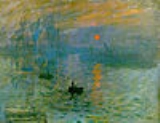
Impressionism
Overview
Art movement
An art movement is a tendency or style in art with a specific common philosophy or goal, followed by a group of artists during a restricted period of time, or, at least, with the heyday of the movement defined within a number of years...
that originated with a group of Paris-based artists whose independent exhibitions
Art exhibition
Art exhibitions are traditionally the space in which art objects meet an audience. The exhibit is universally understood to be for some temporary period unless, as is rarely true, it is stated to be a "permanent exhibition". In American English, they may be called "exhibit", "exposition" or...
brought them to prominence during the 1870s and 1880s. The name of the style is derived from the title of a Claude Monet
Claude Monet
Claude Monet was a founder of French impressionist painting, and the most consistent and prolific practitioner of the movement's philosophy of expressing one's perceptions before nature, especially as applied to plein-air landscape painting. . Retrieved 6 January 2007...
work, Impression, soleil levant (Impression, Sunrise
Impression, Sunrise
Impression, Sunrise is a painting by Claude Monet. It gave rise to the name of the Impressionist movement.-History:...
), which provoked the critic Louis Leroy
Louis Leroy
Louis Leroy was a French 19th century engraver, painter, and successful playwright. However, he is remembered as the journalist and art critic for the French satirical newspaper Le Charivari, who coined the term "impressionists" to satirise the artists now known by the word.Leroy's review was...
to coin the term in a satiric
Satire
Satire is primarily a literary genre or form, although in practice it can also be found in the graphic and performing arts. In satire, vices, follies, abuses, and shortcomings are held up to ridicule, ideally with the intent of shaming individuals, and society itself, into improvement...
review published in the Parisian newspaper Le Charivari
Le Charivari
Le Charivari was an illustrated newspaper published in Paris, France from 1832 to 1937. It published caricatures, political cartoons and reviews...
.
Characteristics of Impressionist paintings include relatively small, thin, yet visible brush strokes; open composition
Composition (visual arts)
In the visual arts – in particular painting, graphic design, photography and sculpture – composition is the placement or arrangement of visual elements or ingredients in a work of art or a photograph, as distinct from the subject of a work...
; emphasis on accurate depiction of light in its changing qualities (often accentuating the effects of the passage of time); common, ordinary subject matter; the inclusion of movement as a crucial element of human perception and experience; and unusual visual angles.
The development of Impressionism in the visual arts
Visual arts
The visual arts are art forms that create works which are primarily visual in nature, such as ceramics, drawing, painting, sculpture, printmaking, design, crafts, and often modern visual arts and architecture...
was soon followed by analogous styles in other media which became known as Impressionist music
Impressionist music
Impressionism in music was a tendency in European classical music, mainly in France, which appeared in the late nineteenth century and continued into the middle of the twentieth century. Similarly to its precursor in the visual arts, musical impressionism focuses on a suggestion and an atmosphere...
and Impressionist literature
Impressionism (literature)
Influenced by the Impressionist art movement, many writers adopted a style that relied on associations. The Dutch Tachtigers explicitly tried to incorporate impressionism into their prose, poems, and other literary works...
.
Impressionism also describes art created in this style, but outside of the late 19th century time period.
Radicals in their time, early Impressionists violated the rules of academic painting.
Unanswered Questions

